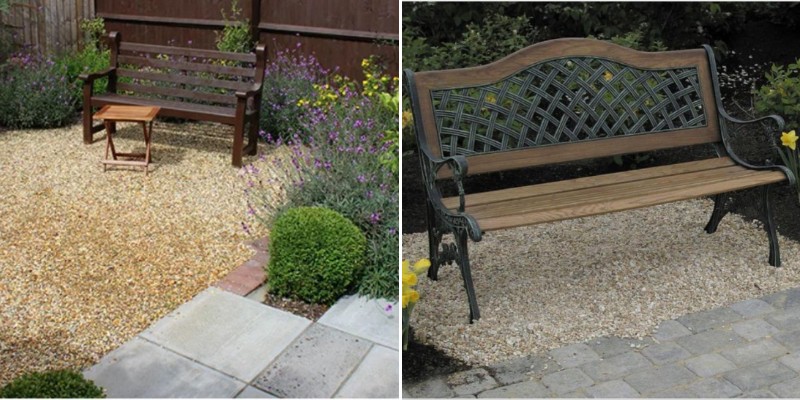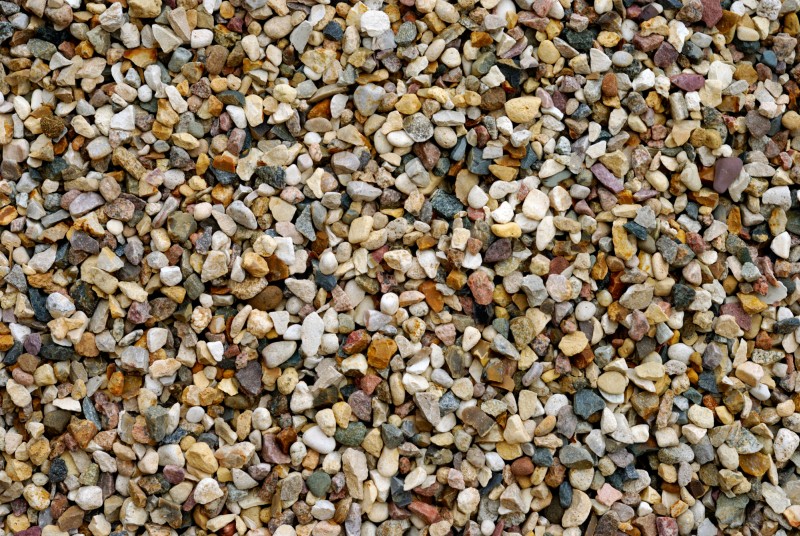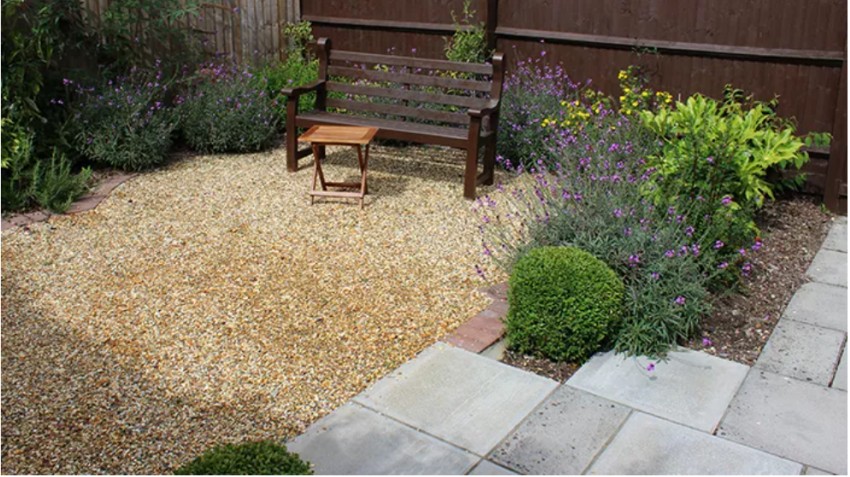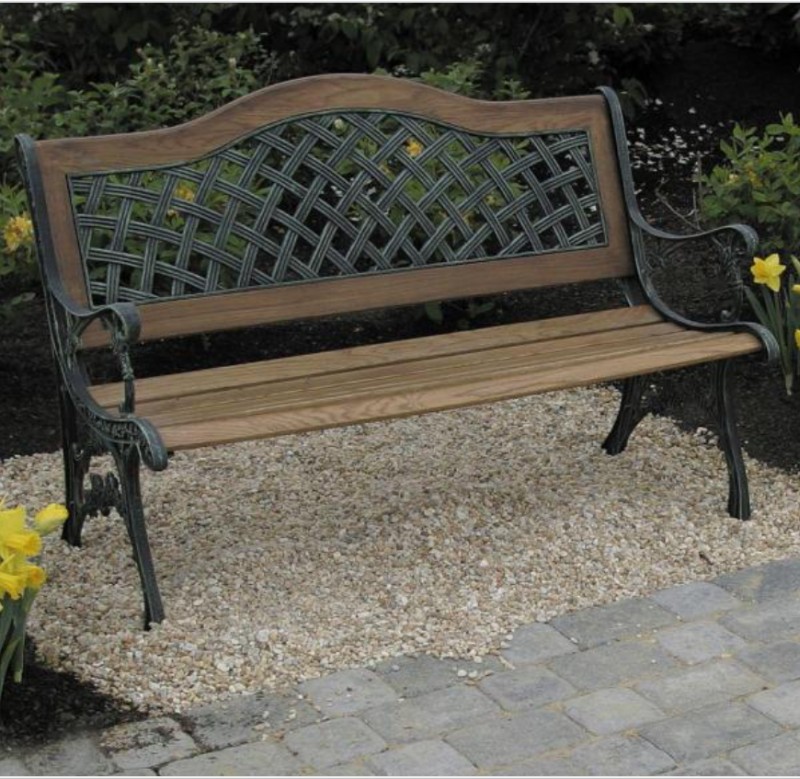In this article we’ll discuss the Pros and Cons of Pea Gravel when used to create a Patio in your home.

Pea gravel is a favorite for “hardscaping” due to its attractive appearance, good drainage and easy installation.
Pea gravel is also a kid-friendly crushed stone when compared to other options because it’s slightly softer to the touch.
Many people choose this material option to use for a patio in their backyard, so let’s see the advantages and disadvantages it offers.
What is pea gravel?
Pea gravel is made from small stones. It’s no surprise that staring at a pea gravel patio gives people the subtle feeling that they’re in a natural environment near a riverbed.
Pea gravel is naturally found near water. Its rounded surface is a “smoothing” effect from water.
Many people choose to use pea gravel for patios because they are drawn to the natural, fresh appearance of this option and also its one of the easiest methods to create a patio.
However, it’s important to know about the pros and cons of a pea gravel patio before you begin planning your new outdoor space. Take a look at all there is to know about pea gravel.

The Main Advantages of a Pea Gravel Patio
Pea gravel is often a first choice among people who decide they don’t want a concrete or brick patio.
In fact, pea gravel is a popular choice among people who prefer to get DIY patios done in a weekend instead of calling a contractor.
Take a look at the benefits of using pea gravel for a patio.
1. Pea Gravel Is a Cheap Option for Patios
A pea gravel patio can cost a fraction of the cost of installing a concrete, brick or paver patio.
There’s also no need to worry about putting down a solid foundation or meticulously leveling the area beforehand.
Pea gravel cuts costs for both materials and labor. What’s more, a pea gravel patio can be a great temporary option until you’re ready to build an ornate patio or deck one day.
2. Diversity of Design Options
Unlike some stones, pea gravel isn’t uniform. It comes in a wide variety of shapes, colors and sizes.
It typically comes in earthy shades of gray, tan, yellow and brown that fit in nicely with landscaping.
3. Low Maintenance
Forget about sealing, power washing or repairing cracks! Pea gravel is essentially a self-sustaining material.
The stones allow for easy drainage to prevent erosion. The nice part about pea gravel is that you can handle maintenance on your own by simply filling in any areas that look skimpy with some new pea gravel that you buy at the local home-improvement store.
4. You Can Build the Patio on Your Own
There is so much DIY potential with pea gravel! Anyone with a shovel, a little bit of time and a vision can design a patio space easily.
One factor that makes this material especially perfect for DIY patios is that its exceptional drainage means that you don’t have to worry about creating a slight incline for drainage the way you do with bricks and pavers.
This turns building a patio from an expert engineering project to an easy item on your weekend to-do list.
5. It’s Easy to Walk Over
One of the big downsides to using stones in landscaping is that stones have sharp edges that can hurt with the wrong step.
This isn’t the case with pea gravel. This product is naturally weathered with soft, rounded edges.
These are very soft rocks that are actually used in playgrounds commonly. It’s perfectly fine to walk out to a pea gravel patio in the morning with bare feet without worrying about sharp edges!
6. Prevents Weed Growth
Using pea gravel is a favorite “hack” of landscapers. It provides an aesthetically appealing way to tamp down weed growth.
However, ambitious weeds can poke through pea gravel if the area isn’t prepared properly prior to beginning a patio installation.
The secret is to always turn the soil under the spot where your pea gravel will go to disrupt existing weeds.
This should allow you to enjoy a weed-free patio area. Many people who install such patios actually use “accent” pea gravel in garden areas and walkways to tie the look together while preventing weed growth.

Main Disadvantages of Pea Gravel Patio
1. You Might Have Problems With Heavy Snow
The “looseness” of pea gravel can be a disadvantage in colder climates where snow is common.
The problem with loose stone is that it’s difficult to shovel without disrupting the design.
Removing snow from pea gravel is more challenging than removing snow from brick or cement. However, this won’t necessarily be a problem if you don’t intend to shovel your deck out in the winter.
2. Requires Landscaping Fabric Beneath the Patio to Separate Dirt and Gravel
While pea gravel requires much less preparation than other options, you’ll still need to do some extra steps before you can put down your stones.
It’s very important to place landscaping fabric down in the outline of your future patio. This will add a layer between the dirt and gravel to create a more stable patio and prevent weeds from growing.
3. Gravel Might Shift From Its Place
Shifting is always a concern whenever you’re using stones for landscaping. The good news is that putting down landscaping fabric will help to preserve the “structure” of a such patio.
However, there’s no guarantee that stones will stay in place forever. It’s very easy for stones to shift with human movement. They can also sink into the soil over time.
4. Needs an Edge Barrier to Keep It in Place
You’ll need to come up with a plan to install an attractive edge barrier to keep a pea gravel patio in place.
This can require a little bit of construction. Many people use wood edging, bricks or large pavers. It’s also possible to create a landscape plan that lines your new pea gravel patio with wooden garden boxes.
The sky is really the limit when it comes to coming up with a design because this material option can be used to make patios of all shapes.
5. Using Furniture Can Be Complicated
A pea gravel patio doesn’t provide the stable surface for heavy patio furniture that you get with something like a cement patio.
It can sometimes feel awkward when chairs shift and sink on such a surface. However, packing pea gravel tightly can help to reduce the “fluidness” of the patio.
6. Potential Hazard to Children
The good news is that pea gravel stones don’t have sharp edges that can hurt children. However, that doesn’t make this a completely child-safe option. The small stones can pose choking risks for young children.

Frequently Asked Questions About Pea Gravel
What Is the Cost of Pea Gravel?
Pea gravel costs can vary based on where you live. The average cost per ton is between $25 and $75 for colored stones or $10 to $50 for regular gravel.
Bags that can cover around 2.75 sq feet of area are sold for around $5 at home-improvement stores.
Does Pea Gravel Need a Base for Patios?
Pea gravel doesn’t require any kind of base or foundation. You also don’t need to install it on a slight incline for drainage the way you do with other materials.
However, it is highly recommended to put down landscaping fabric in the shape of the pea gravel patio you will be building to separate the dirt from the stone and to block weeds from growing.
Professionals also recommend to put a layer of crashed stone as a base before installing the landscaping fabric and then the actual pea gravel.
Does Pea Gravel Drain Well?
Yes! Pea gravel is excellent for drainage because water will seep right through the stones. Pea gravel comes from river stone that handles moisture beautifully.
Related Posts
- Want to Redo Your Lawn? Here Are Your Options
- Stylish Front Yard Landscaping Ideas On a Budget
- LED Outdoor Commercial Lighting Ideas for Homes
- 6 Factors That Make A Pond For All Seasons in your Garden
- Create a Beautiful Outdoor Living Space on a Budget
- Landscapers Near Me – Best Landscaping Companies (Free Estimates)
Leave a Reply